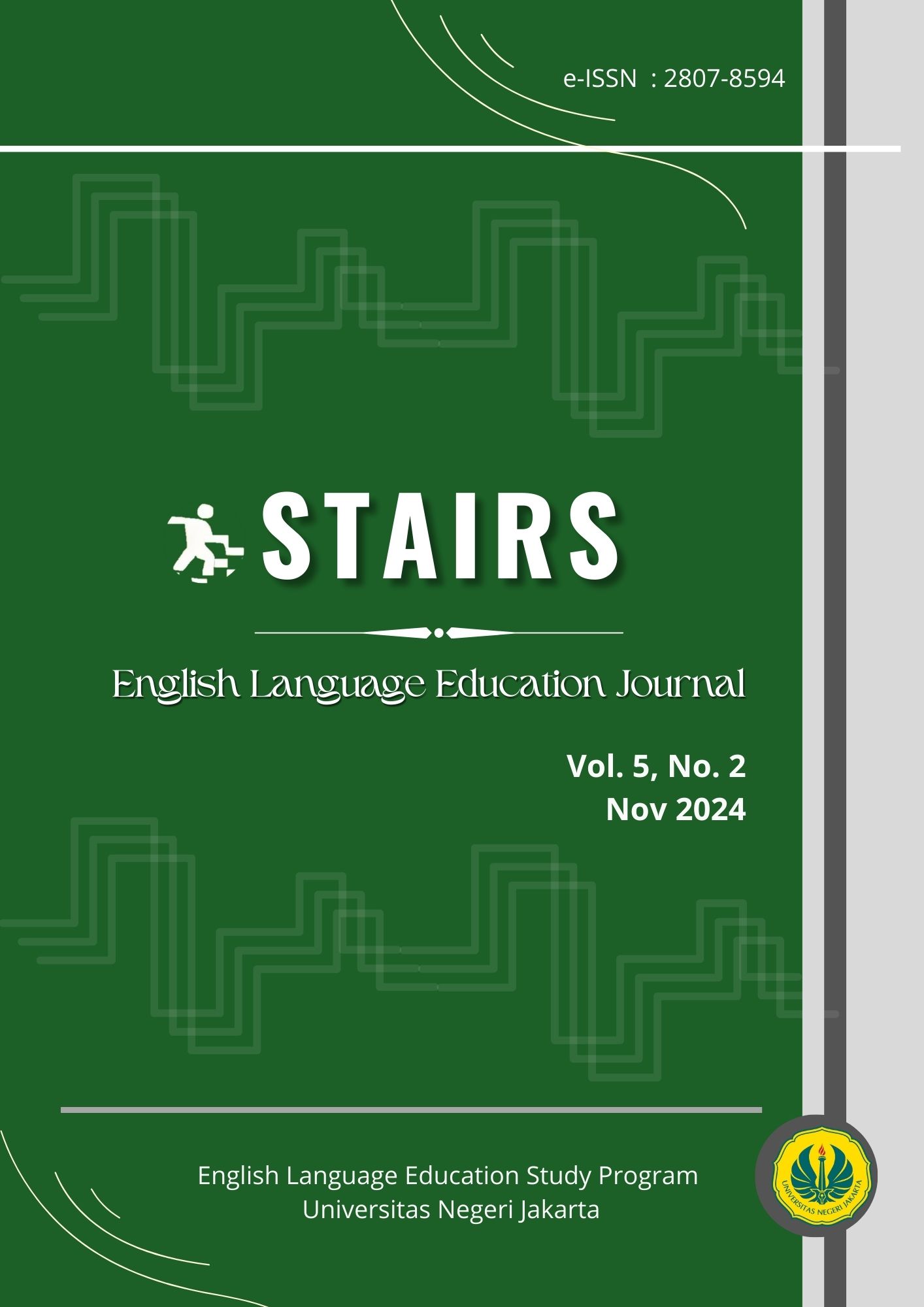The Existence of CEFR Reception Competence of Communicative Language Activities in TikTok
DOI:
https://doi.org/10.21009/stairs.5.2.4Keywords:
CEFR, Communicative Language Activities, Reception Competence, TikTokAbstract
The Common European Framework of Reference for Languages (CEFR) provides a standardized measure of language proficiency, guiding language learning and assessment globally. With the increasing use of digital media, videos have become an influential tool in language acquisition. TikTok, as a popular social media platform, offers engaging content that may support language learning. However, limited research has explored how TikTok videos align with CEFR communicative competence descriptors. This study aims to analyze the CEFR competence level of reception communicative activities in TikTok videos using the illustrative descriptor scale. Employing a qualitative approach, the research utilizes ATLAS.ti software to analyze 200 TikTok videos collected through the hashtag #learnenglish. The findings reveal that the most frequently occurring descriptor is overall oral comprehension, appearing in 62 videos, while the A1 level is the most represented, accounting for 25% (50 videos). These results suggest that TikTok videos predominantly cater to beginner-level learners. The study highlights the potential of TikTok as a supplementary language learning tool and provides insights for future research on optimizing digital platforms for CEFR-aligned language education.
References
Anumanthan, S., & Hashim, H. (2022). Improving the learning of regular verbs through TikTok among primary school ESL pupils. Creative Education, 13, 896-912.. https://doi.org/10.4236/ce.2022.133059
Common European Framework of Reference. (2020). Common European Framework Learning, Teaching, for Languages: Of Reference Assessment. Clinical Neurophysiology, viii. https://doi.org/10.1016/b978-0-7506-1183-1.50003-6
Darmi, R., Mat Saad, N. S., Abdullah, N., Puteh-Behak, F., Zakaria, Z. A., & Adnan, J. N. I. A. (2017). Teachers’ views on students’ performance in English language proficiency courses via CEFR descriptors. IJAEDU- International E-Journal of Advances in Education, 3(8), 363–370. https://doi.org/10.18768/ijaedu.336688
Fennely, M. G. (2016). The influence of CEFR on English language education in Japan. Bulletin of Shikoku University, (A)46, 109-122.
Fleckenstein, J., Leucht, M., & Köller, O. (2018). Teachers ’ judgement accuracy concerning CEFR levels of prospective university students. Language Assessment Quarterly, 15(1), 1–12. https://doi.org/10.1080/15434303.2017.1421956
Herlisya, D., & Wiratno, P. (2022). Having good speaking English through Tik Tok application. Journal Corner of Education, Linguistics, and Literature, 1(3), 191–198. https://doi.org/10.54012/jcell.v1i3.35
Holzknecht, F., Huhta, A., & Lamprianou, I. (2018). Comparing the outcomes of two different approaches to CEFR-based rating of students ’ writing performances across two European countries. Assessing Writing, 37(March), 57–67. https://doi.org/10.1016/j.asw.2018.03.009
Ika, R. M, & Santosa, I. (2023). The existence of CEFR interaction competence of communicative language activities in TikTok. STAIRS: English Language Education Journal, 4(2).
Istifci, I. & Ucar, A. D. (2021). A Review of research on the use of social media in language teaching and learning. Journal of Educational Technology and Online Learning, 4(3), 475-488.
Khair, A. H. M., & Shah, P.M. (2021). ESL teachers’ perceptions on the implementation of CEFR in Malaysian primary schools: Issues and challenges. Journal of Advances in Education Research, 6(1), 31–48. https://doi.org/10.22606/jaer.2021.61005
Mamudi, S. F., & Alamry, T. C. S. (2021). Students’ perception on the use of instagram to learn English vocabulary. SintuwumarosoJET, 7(1)., http://dx.doi.org/10.71127/2829-9426.411
Mohamed, S. (2023). The development of an Arabic curriculum framework based on a compilation of salient features from CEFR level descriptors. Language Learning Journal, 51(1), 33–47. https://doi.org/10.1080/09571736.2021.1923781
Lee, Y. J. (2023). Language learning affordances of Instagram and TikTok. Innovation in Language Learning and Teaching, 17(2), 408–423. https://doi.org/10.1080/17501229.2022.2051517
Prisia, K., & Melor, Y. (2019). Blended CEFR in enhancing vocabulary among low proficiency students. Arab World English Journal, 13.
Ratnaningsih, L., & Gumiandari, S. (2022). The impact of TED YouTube channel to improve listening in English learning students of TBI IAIN Cirebon. International Journal of Educational Qualitative Quantitative Research, 1(1), 8–15. https://doi.org/10.58418/ijeqqr.v1i1.2
Stemler, S., & Scott, R. A. (2015). Content analysis. In R. A. Scott & S. M. Kosslyn (Eds.), Emerging trends in the social and behavioral sciences: An interdisciplinary, searchable, and linkable resource (pp. 1-14). Wiley. https://doi.org/10.1002/9781118900772.etrds0053
Syakirah, H., & Santosa, I. (2024). The communicative language strategies of CEFR in Tiktok video. STAIRS: English Language Education Journal, 5(1)
Yélamos-Guerra, M. S., García-Gámez, M., & Moreno-Ortiz, A. J. (2022). The use of TikTok in higher education as a motivating source for students. Porta Linguarum, 38, 83–98. https://doi.org/10.30827/portalin.vi38.21684
Zhang, J. (2021). An exploratory research of Chinese undergraduate students ’ English literature informal learning through social media Apps. ERMSS. https://doi.org/10.25236/ermss.2021.007



